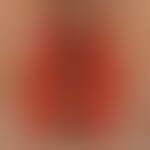Synonym(s)
DefinitionThis section has been translated automatically.
STD ( = sexually transmitted disease), in the last decades clearly increasing infectious disease caused by human papilloma viruses (HPV) with formation of initially only a few, pointed soft papules with a tendency to rapid seeding as well as the formation of wart-like plaques and large-area beet-like or nodular growths.
PathogenThis section has been translated automatically.
Viruses of the Papova group (HPV, see below Papillomaviruses, human), mostly HPV 6 and 11. At the same time, co-infections with other different HPV types may be present, e.g. HPV 16, 18, 31, 33, 35, 39, 45, 51, 52, 56, 58, 59 and 66.
HPV 16, 18, 31, 45 will be a high risk of carcinoma (almost always detectable in cervical carcinoma),
HPV 33, 35, 39 a medium risk (detection in 1-5% of invasive growing cervical carcinomas)
and HPV 6 and 11 a lower risk (only rarely detected in invasively growing cervical carcinomas).
HPV 16 is found in nearly 100% of bowenoid papulosis. HPV 6 and 11 are also causative agents of laryngeal papillomas.
You might also be interested in
Occurrence/EpidemiologyThis section has been translated automatically.
EtiopathogenesisThis section has been translated automatically.
Transmission from person to person by direct contact, especially during sexual intercourse. This is favored by a moist environment, e.g. vaginal fluoride, urethritis, intertrigo, phimosis, eczema, anal eczema, possibly ovulation inhibitors, immune deficiency.
In children with condylomata in the genital and anal areas, the duty of care requires that possible evidence of child abuse be investigated. A psychosocial history is important. Furthermore, it is important to eliminate a possible source of infection. Behavioral disorders of the children, disorders of the parent-child relationship should be investigated together with a child psychologist, if necessary.
ManifestationThis section has been translated automatically.
LocalizationThis section has been translated automatically.
ClinicThis section has been translated automatically.
Initially small, 0.2-0.5 cm in size, reddish to grayish-yellow, soft nodules, which rarely occur singly, but usually multiply, disseminated, or may aggregate to form large, warty, fissured plaques or nodules. On maceration, transition to slimy, foul-smelling, disintegrating growths.
Condylomas may also occur beyond the mucosal area; they appear, for example, on the shaft of the penis, then as soft pigmented papillomas, which then resemble pigmented seborrheic keratoses (atypical localization).
Special forms:
HistologyThis section has been translated automatically.
Sharply limited, exophytic neoplasm with voluminous acanthosis with widened and extended reticulum, low hyperkeratosis and focal parakeratosis. In contrast to the vulgar warts there is no accentuation and widening of the str. granulosum. Koilocytes are diagnostically important, but often occur as distinctly as in verruca vulgaris. Subepidermal mostly sparse round cell infiltrate.
Differential diagnosisThis section has been translated automatically.
Anal:
AIN, anal carcinoma: important differential diagnosis; scaly, whitish, erythematous, eczematous, papillomatous, papular, pigmented or fissured plaques described. Induration and ulceration may be evidence of invasion.
Marisci: common; nonreducible, solitary or multiple, indolent, flaccid skin folds that do not fill on pressing. Condylomata lata: rare; weeping, broad-based papules and plaques; foul foetor, masses of spirochetes detectable in dark field chronic anal eczema of various etiologies: bulging thickening and lichenification of skin and semi-mucous membrane with erythema and rhagades as well as punctate and extensive erosions, line-shaped scratch marks as an expression of the usually intense itching.
Penis and glans penis:
Pseudocondyloma = Hirsuties papillaris penis: Formation of row-like, reactionless papillary or filiform, whitish-red nodules at the proximal edge of the glans before the transition into the sulcus coronarius; never aggregation of the papules. PIN: - usually corresponds to the findings of erythroplasia - with usually painless, solitary, rich red, sharply circumscribed, velvety granular, sometimes plate-like focus; never verrucous. Bowenoid papules: Usually multiple, 0.2-0.5 cm in size, flat, reddish-brown (reminiscent of lichen planus) irregularly circumscribed papules with usually smooth or velvety, but occasionally verrucous, then usually whitish tinged surface.
Penile shaft
Scabies granulomatosa: rarely found in the glans penis area, usually penile shaft, there as solitary or grouped red, itchy firm papules. Verruca seborrhoica: Usually sharply circumscribed, mostly disseminated, roundish to oval, 0.5 - 1.0 cm in size, soft, raised, grey-brown or also black papules or nodules with a fissured, warty surface, sitting broadly on the lower surface.
General therapyThis section has been translated automatically.
The choice of procedure (conservative or surgical) depends on the number and location, size and morphology of the lesions as well as the personal experience of the therapist. Since human papilloma viruses exclusively infect epithelial cells, the complete ablation of the epithelial layer should be aimed for.
Common to all surgical procedures is the need for adequate anesthesia. Surface anaesthesia is usually not sufficient for extensive infestation, so that depending on the findings, local, spinal or general anaesthesia should be used.
Concomitant diseases: If necessary, the treatment of an underlying disease such as gonorrhoea, candidiasis, phimosis, syphilis, oxyuriasis, immunodeficiencies, etc. must be taken into account.
- In the anal region: exclusion of rectal diseases such as internal haemorrhoids, chronic proctitis, rectal gonorrhoea and other sexually transmitted diseases. Partner treatment or prophylaxis of infection of the partner (condoms!) are of decisive importance!
- Especially in the case of anal condylomata acuminata in homosexual men, a test for HIV should always be carried out.
External therapyThis section has been translated automatically.
- For self-treatment for small non-inflammatory condylomas on the penis, podophyllotoxin can be applied as a cream (Wartec-Creme®) or solution (Condylox-Lsg.®). Side effects may include painful erosions and inflammatory swelling of the treated areas.
- Good results can be obtained with Imiquimod (e.g. Aldara ®5%): application 3 times/week over 6-10 hours (e.g. overnight) for a total of 12 weeks. The procedure is also indicated for the "post-treatment" of condylomata acuminata, e.g. after surgical removal of condylomas. For perianal condylomata, the magistral formulation of suppositories with 5% imiquimod has proven effective.
- Application of trichloroacetic acid (concentration up to 85%) by means of a cotton swab 1 time/week (by the physician). Use only in very small quantities. In case of overdosage, neutralisation with sodium bicarbonate solution is necessary. Healing without scarring. Safe to use during pregnancy. Local side effects are burning and pain in the area of application.
- Alternatively, the locally well tolerated active agent polyphenone ( epigallocatechin gallate) is recommended, a catechin extract(see below tannins) which is extracted from the leaves of the green tea (Veregen®). The ointment is available as a 10% application form and has been evaluated in 2 large placebo-controlled (>600 patients) studies. The catechin extract inhibits the excessive proliferation of HPV-infected keratinocytes. The green tea extract ointment (Veregen®) must not be applied vaginally, cervically, anally, perianally and intraurethrally as it may cause ulceration there.
Operative therapieThis section has been translated automatically.
Small Condylomata:
General: Targeted surgical methods offer higher success rates and fewer side effects in small condylomata.
- First-line therapy is curettage with sharp spoon in LA or under icing; followed by electrocautery with ball cautery. Careful inspection intravaginally and anally to capture all foci.
- Alternative: electrocautery with conventional monopolar electrodesiccation. The skin around the condyloma should also be coagulated, as these keratinocytes usually contain viral genome. The depth effect is not always assessable.
- Alternative: Ablation with CO2, YAG or diode laser systems. Advantage of laser procedures: bloodless surgical area, less postoperative discomfort. Disadvantage: Greater effort. Remark: Vaporization of condylomas is intensive in case of extensive findings. During this process, potentially infectious viral particles are released into the room air. Protective goggles and masks as well as smoke evacuation are obligatory!
Large condylomata:
- In the presence of a few, circumscribed condylomas, ablation with a diathermy snare in LA is favorable. Otherwise curettage and subsequent electrocoagulation with a ball probe (if necessary, ablation in layers).
- Alternative: Ablative laser procedure (see above).
- Alternative: S.o.
Disseminated condylomata:
- Electrocautery, curettage and layer-by-layer ablation under general anesthesia is indicated for disseminated condylomata acuminata in the genital area and intraanal.
- Circumcision in case of infestation of the penis, reduces the recurrence rate.
Recurrent condylomata:
- Treatment regimens see above.
- Circumcision in case of penile involvement.
- Alternative: Adjuvant interferon therapy after surgery (3 million IU interferon alpha s.c. 3 times/week for at least 16 weeks).
- Alternatively Imiquimod (e.g. Aldara) 3 times/week for 3 months in combination with ablative Co2 laser therapy.
- Experimental: monotherapy with 2 times " photodynamic therapy".
Condylomata in pregnancy:
Condylomata manifesting in pregnancy may represent an initial infection, or they may have arisen from reactivation of a subclinical HPV infection.
The risk of transmission is low but possible. Of particular concern is perinatal infection of the larynx with HPV 6 or HPV 11, which may result in juvenile laryngeal papillomas.
Local trichloroacetic acid and surgical procedures or the CO2 laser can be used for treatment.
Caesarean section is indicated only in cases of obstruction of the birth canal by condylomas.
Progression/forecastThis section has been translated automatically.
ProphylaxisThis section has been translated automatically.
In a multicenter study, a quadrivalent HPV vaccine in young women aged 16-23 years achieved a significant decrease in HPV 6, 11, 16 and 18 induced infections for the first time. Meanwhile, the nine-valent vaccine (Gardasil®9) has also been shown to protect against condylomata acuminata. Up to 90% of these are caused by HPV types 6 and 11.
Currently, statutory health insurance companies in Germany cover the cost of vaccinations for young women and men aged 9-15 years. If the vaccination is missed, it can and should be made up until the age of 17.
Currently, therapeutic HPV vaccination for (recurrent) condyloma in males is not recommended, but all available HPV vaccines are licensed with no age limit starting at age 9 years. The costs for vaccinations of adult males after completion of the 18th year of age must be clarified with the health insurance companies in advance. Whether a booster vaccination is necessary in the course cannot be answered with certainty at present. However, initial studies of women show no decrease in HPV protection 12 years after the last vaccination.
NaturopathyThis section has been translated automatically.
Accompanying immunostimulating therapy with ecchinacea, Uncaria tomentosa, papaya products(e.g. the carotenoid lycopene) is considered helpful.
s.a. Epigallocatechin gallate, s.a. Tea, green, Camelliae sinensis non fermentata folia
AftercareThis section has been translated automatically.
Note(s)This section has been translated automatically.
LiteratureThis section has been translated automatically.
- Burstein GR et al (2003) Sexually transmitted diseases treatment guidelines. Curr Opin Pediatr 15: 391-397
- Kreuter A et al (2006) 5% imiquimod suppositories decrease the DNA-load of intra-anal HPV-types 6 and 11 in HIV-infected men after surgical ablation of condylomata acuminata. Arch Dermatol 142: 243-244
- Lacey CJ et al (2003) Randomised controlled trial and economic evaluation of podophyllotoxin solution, podophyllotoxin cream, and podophyllin in the treatment of genital warts. Sex Transm Infect 79: 270-275
- Ockenfels HM (2016) Therapeutic management of cutaneous and genital warts. J Dtsch Dermatol Ges 14:892-899.
- Sauder DN et al (2003) Topical imiquimod 5% cream as an effective treatment for external genital and perianal warts in different patient populations. Sex Transm Dis 30: 124-128
- Snowy P (2001) Urethral condylomata. A therapeutic challenge. dermatologist 52: 411-417
- Speck LM (2006) Vaccines for the prevention of human papillomavirus infections. Skin Therapy Lett 11: 1-3
- Stockfleth E et al (2008) Topical Polyphenon E in the treatment of external genital and perianal warts: a randomized controlled trial. Br J Dermatol 158:1329-1338
- Toro JR et al (2003) Topical cidofovir for the treatment of dermatologic conditions: verruca, condyloma, intraepithelial neoplasia, herpes simplex and its potential use in smallpox. Dermatol Clin 21: 301-309
- Villa LL et al (2006) High sustained efficacy of a prophylactic quadrivalent human papillomavirus types 6/11/16/18 L1 virus-like particle vaccine through 5 years of follow-up. Br J Cancer 95: 1459-1466
- Weyandt GW (2011) New therapeutic approaches for the treatment of anogenital HPV infections. Dermatologist 62: 28-33
Incoming links (54)
Ain; Amebiasis; Anal carcinoma; Analpruritus; Analpruritus; Bowenoids papulose; Camelliae sinensis non fermentata folia; Catechine; Catechine; Condylomas, pointed; ... Show allOutgoing links (36)
Ain; Anal dermatitis (overview); Bowenoids papulose; Camelliae sinensis non fermentata folia; Candidoses; Catechine; Circumcision; Curettage; Electrocoagulation; Epigallocatechin gallate; ... Show allDisclaimer
Please ask your physician for a reliable diagnosis. This website is only meant as a reference.













































